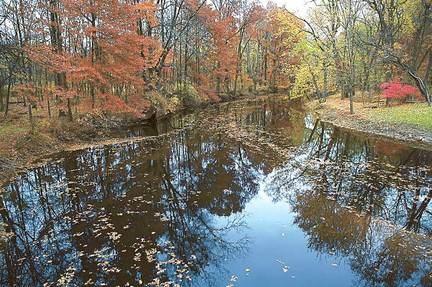
4 minute read
29
Passaic River to Undergo Largest Ever Superfund Rehabilitation
by Alex Toke
(Source: Dave Sanders, the New York Times)
Despite having the largest percentage of protected land of any state in the United States, the state of New Jersey is beset with issues related to environmental contamination that threaten to render its moniker “the Garden State” somewhat of a hypocrisy. The state has the highest number of Superfund sites, which are hazardous waste disposal sites designated per the provisions of the Comprehensive Environmental Response, Compensation, and Liability Act of 1980 (CERCLA). There are numerous sites throughout the state that, though polluted, do not merit the Superfund designation, and many of these are generally not as attentiongrabbing as the incidences at Love Canal in New York and the Valley of the Drums in Kentucky that prompted the passage of CERCLA. However, some of the polluted areas in New Jersey that have succeeded in drawing national attention are the state’s major inland waterways: its rivers. Many Rutgers students are aware, at least in a general sense, of how polluted the Raritan still is, despite largely-successful cleanup efforts over the past several decades rendering it no longer a “dead zone”, but the Delaware River, one of New Jersey and Pennsylvania’s major waterways is one of the top ten mostpolluted rivers in the country. The Passaic, flowing through Newark, New Jersey, is also a highlycontaminated area, and as of this writing is finally set to receive some much-needed rehabilitation in the form of its own major cleanup effort. The Passaic River was an integral part of Newark’s economy during the pre-industrial and industrial eras, supplying water for the city’s residents and manufacturing centers, facilitating the transport of the goods produced there, and ultimately, before environmental statutes began being enforced with any efficacy, conveying the various industrial pollutants used in the manufacturing processes elsewhere. Across the United States it was once common practice to dispose of hazardous material simply by pouring it onto the ground, into drains, or directly into rivers or streams, compounding the host of problems local and federal officials must face when dealing with the scope of environmental cleanup operations. In the case of such a massive operation as necessitated by the Passaic, the amount of resources and personnel necessary are often beyond the means of local, and sometimes state, officials to cope with. Given the extent to which it has been polluted, it is necessary for the federal Environmental Protection Agency to step in to assist in remediating the site, and the Agency is seeking to indemnify polluters via CERCLA for contribution in paying for the costs of such a mammoth operation. The cleanup of the lower eight miles of the Passaic is estimated to cost more than $1.38 billion. Judith A. Enck, regional administrator of the EPA, declared negotiation with the various corporations deemed to be

Volume 8, Issue 5 responsible for the century’s worth of pollution layered at the bottom of the river will take one year, and that dredging would take another ten. The idea that taxpayers should not be footing the bill for this cleanup is at the forefront of the minds of all those in charge of planning this operation, which is why EPA is seeking contribution from the more than 100 corporations responsible. This will be the largest cleanup operation ever attempted under CERCLA, and the dredged soil from the lower eight miles of the Passaic from Belleville to Newark will be enough to fill nearby Red Bull Stadium three times over. This plan is a lofty increase from the previous settlement, reached in 2014, in which a New Jersey Superior Court Justice ruled that polluters would have to pay the state $190 million, a settlement that was universally panned by state officials and environmental activists. Senator Cory Booker (D-NJ), former mayor of Newark had this to say at a press conference: “Please understand that there should be yellow crime-scene tape around the Passaic River right now.” He lamented “the damage that has been done, the lives that have been affected, the disease that has been spread, [and] the theft from opportunity” and other costs that he said were borne by the people of New Jersey. The discussion about this immense undertaking has been ongoing for years though, and hopefully now discussion of dollar amounts and liability can give way to actual action and relief for the communities that have been grievously affected for so long.


(Source: Laura Herzog, NJ Advance Media for nj.com ) (Source: www.nj.com)

Works Referenced:
- Remnick, Noah, and Rojas, Rick. (2016, March 6). Toxic Passaic River to Get $1.38 Billion Cleanup Over 10 Years. The New York Times. Retrieved from http://www.nytimes.com/2016/03/05/nyregion/toxic-passaicriver-to-get-1-38-billion-cleanup-over-10-years.html.
- Sherman, Ted. (April 11, 2014). Massive, $1.7 Billion Environmental Cleanup of Passaic River Proposed by EPA. Retrieved from http://www.nj.com/news/index.ssf/2014/04/ massive_17_billion_cleanup_of_passaic_river_proposed_by_epa.html.
- United States Environmental Protection Agency. (March 3, 2016). Record of Decision: Lower 8.3 Miles of the Lower Passaic River. Retrieved from https://semspub.epa.gov/work/02/396055.pdf.







